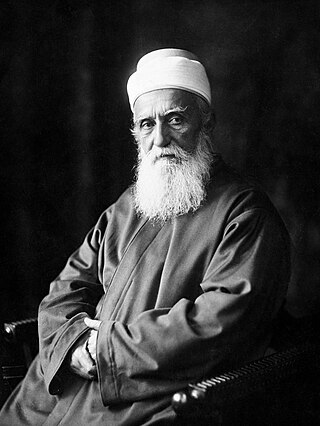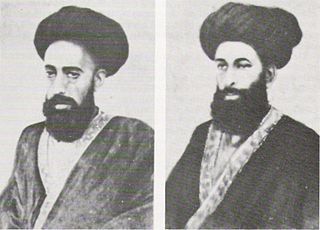
ʻAbdu'l-Bahá, born ʻAbbás, was the eldest son of Baháʼu'lláh and served as head of the Baháʼí Faith from 1892 until 1921. ʻAbdu'l-Bahá was later canonized as the last of three "central figures" of the religion, along with Baháʼu'lláh and the Báb, and his writings and authenticated talks are regarded as sources of Baháʼí sacred literature.
Covenant-breaker is a term used in the Baháʼí Faith to refer to a person who has been excommunicated from the Baháʼí community for breaking the Covenant of Baháʼu'lláh, meaning actively promoting schism in the religion or otherwise opposing the legitimacy of the chain of succession of leadership. Excommunication among Baháʼís is rare and not used for transgressions of community standards, intellectual dissent, or conversion to other religions. Instead, it is the most severe punishment, reserved for suppressing organized dissent that threatens the unity of believers.

Sayyid Kāẓim bin Qāsim al-Ḥusaynī ar-Rashtī (1793–1843), mostly known as Siyyid Kázim Rashtí, was the son of Siyyid Qasim of Rasht, a town in northern Iran. He was appointed as the successor of Shaykh Ahmad al-Ahsa'i, and led the Shaykhí movement until his death.
Baháʼu'lláh was the founder of the Baháʼí Faith. He was born in 1817 to Khadíjih Khánum and Mírzá Buzurg of Nur, a Persian nobleman, and went on to be a leader in the Bábí movement, and then established the Baháʼí Faith in 1863. Baháʼu'lláh's family consists of his three wives and the children of those wives.
The following is a basic timeline of the Bábí and Baháʼí religions emphasizing dates that are relatively well known. For a more comprehensive chronology of the timeline, see the references at the bottom.

The Baháʼí World Centre buildings are buildings that are part of the Baháʼí World Centre in Israel. The Baháʼí World Centre buildings include both the Baháʼí holy places used for pilgrimage and the international administrative bodies of the Baháʼí Faith; they comprise more than 20 different administrative offices, pilgrim buildings, libraries, archives, historical residences, and shrines. These structures are all set amidst more than 30 different gardens or individual terraces.
Badíʻ was an eminent early follower of Baháʼu'lláh, founder of the Baháʼí Faith, and considered one of his chief apostles. At the age of 17 he delivered a letter from Baháʼu'lláh to Náṣiri'd-Dín S͟háh, for which he was tortured and killed.
The Baháʼí Faith has its background in two earlier movements in the nineteenth century, Shaykhism and Bábism. Shaykhism centred on theosophical doctrines and many Shaykhis expected the return of the hidden Twelfth Imam. Many Shaykhis joined the messianic Bábí movement in the 1840s where the Báb proclaimed himself to be the return of the hidden Imam. As the Bábí movement spread in Iran, violence broke out between the ruling Shiʿa Muslim government and the Bábís, and ebbed when government troops massacred them, and executed the Báb in 1850.

The Epistle to the Son of the Wolf is the last major work of Baháʼu'lláh, founder of the Baháʼí Faith, written in 1891 just before his death in 1892. It is a letter written to "the son of the Wolf," Shaykh Muhammad Taqi known as Áqá Najafi (1846-1914), a Muslim cleric in Isfáhán, where his family was the most powerful clerical family. Baháʼu'lláh called the father, Shaykh Muhammad Báqir (1819-1883), the Wolf because of his responsibility for the execution of the Nahrí brothers in Isfahan in 1879. The father and son were known for their persecution of the Baháʼís.

Mullá Muḥammad-i-Zarandí, more commonly known as Nabíl-i-Aʻẓam or Nabíl-i-Zarandí, was an eminent Baháʼí historian during the time of Baháʼu'lláh, and one of the nineteen Apostles of Baháʼu'lláh. He is most famous for authoring The Dawn-Breakers, which stands out as one of the most important and extensive accounts of the ministry of the Báb.

The Tablets of Baháʼu'lláh Revealed After the Kitáb-i-Aqdas are selected tablets written by Baháʼu'lláh, the founder of the Baháʼí Faith, and published together as of 1978. The current edition bears the title Fountain of Wisdom: A Collection of Writings from Baháʼu'lláh.
Mírzá Músá was the only full brother of Baháʼu'lláh, meaning that they shared the same mother and father. He was later named by Shoghi Effendi as one of the nineteen Apostles of Baháʼu'lláh.

Mírzá Muḥammad, or Mírzá Abu'l-Faḍl-i-Gulpáygání (1844–1914), was the foremost Baháʼí scholar who helped spread the Baháʼí Faith in Egypt, Turkmenistan, and the United States. He is one of the few Apostles of Baháʼu'lláh who never actually met Baháʼu'lláh. His given name was Muhammad, and he chose the alias Abu'l-Faḍl for himself, but ʻAbdu'l-Bahá frequently addressed him as Abu'l-Fada'il.

Núrayn-i-Nayyirayn are two brothers who were followers of Baháʼu'lláh, the founder of the Baháʼí Faith, a global religion of Persian origin. They were beheaded in 1879 as a result of being Baháʼís. Numerous letters and tablets were written in their honour by Baháʼu'lláh, who gave them the titles which they are commonly known as: the King of Martyrs and the Beloved of Martyrs.
Baháʼí literature covers a variety of topics and forms, including scripture and inspiration, interpretation, history and biography, introduction and study materials, and apologia. Sometimes considerable overlap between these forms can be observed in a particular text.

Mírzá ʻAlí-Muḥammad-i-K͟hurásání, known as Ibn-i-Aṣdaq, was an eminent follower of Baháʼu'lláh, the founder of the Baháʼí Faith. He was appointed a Hand of the Cause and identified as one of the nineteen Apostles of Baháʼu'lláh.
S͟hayk͟h Káẓim-i-Samandar, known as Samandar, was an eminent follower of Baháʼu'lláh, the founder of the Baháʼí Faith. He was born to a prominent Baháʼí family of Qazvin of Bábí and Shaykhi background. Favored by Baháʼu'lláh, he was identified as one of his nineteen Apostles.

Munírih K͟hánum was the wife of ʻAbdu'l-Bahá, a prominent figure in the Baháʼí Faith. She was entitled the Holy Mother. Her memoirs, first published in 1924, are regarded as one of the first published memoirs by a Persian woman in the 20th century.

Mírzá Muḥammad Muṣṭafá al-Baghdádí (1837/8—1910) was a prominent Iraqi adherent of the Baháʼí faith and one of 19 Apostles of Baháʼu'lláh. Mustafá was among the leading Baháʼís in Iraq until he moved to Beirut in the late 1870s, where he coordinated pilgrims going to see Baháʼu'lláh in ʻAkká, and later he was involved with the movement of the Báb's remains to ʻAkká.
The following outline is provided as an overview of and topical guide to the Baháʼí Faith.












